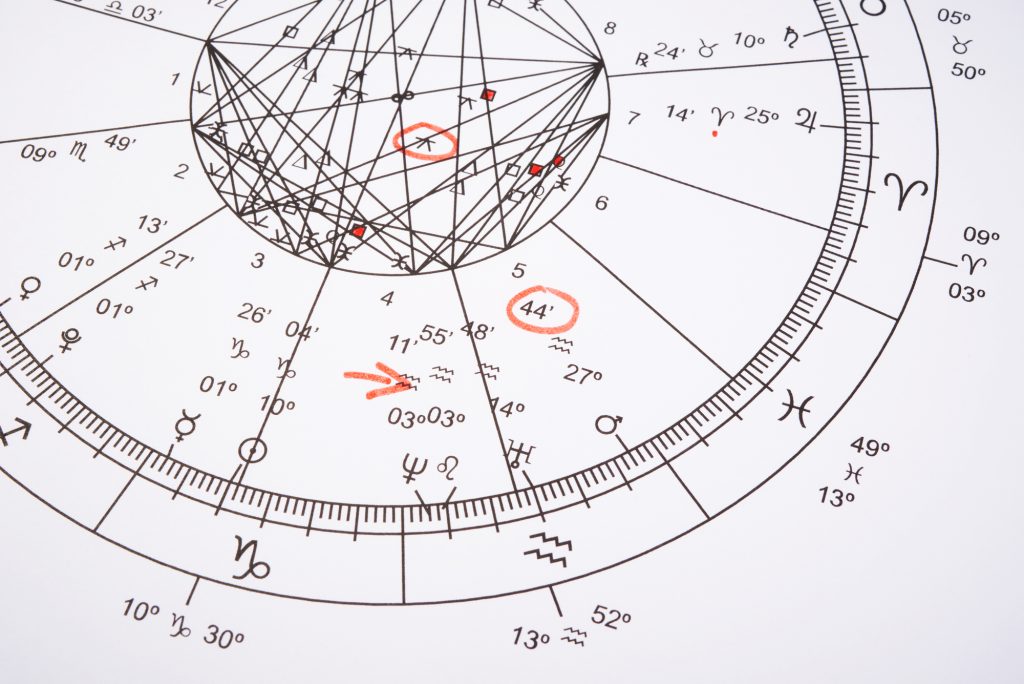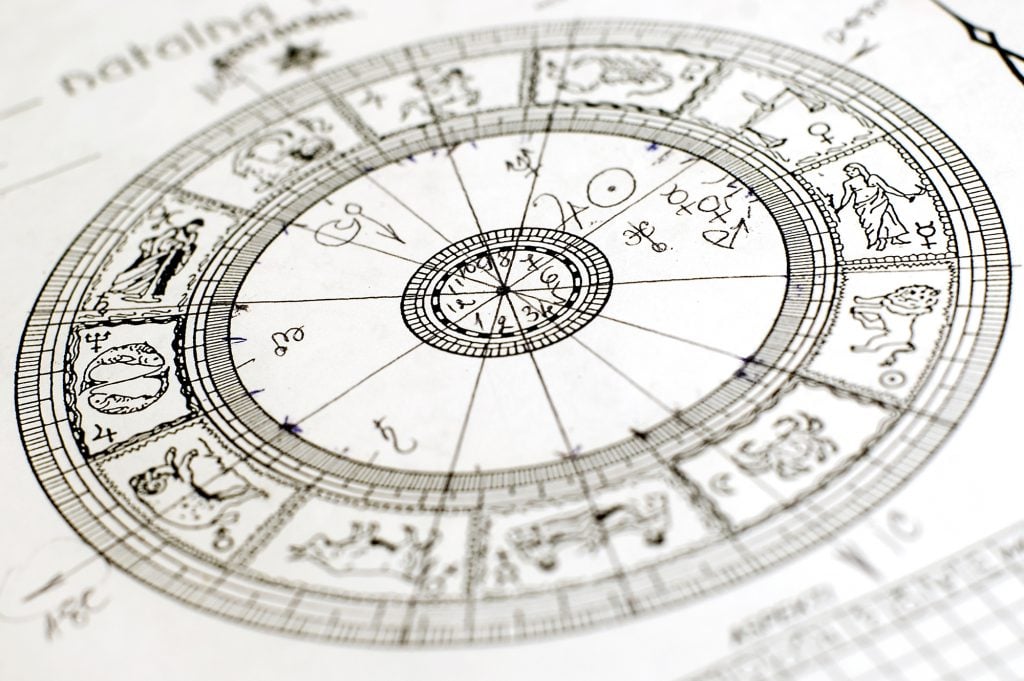Division of the Birth Chart: astrological hemispheres and quadrants

The division of the birth chart is one of the techniques employed by astrologers. It works as a first approach to the nature of the subject, by initiating the interpretation of the natal map. The information obtained, through the division of the birth chart, will be later expanded by studying the layout of houses, planets, signs, and other relevant aspects.
Division of the Birth Chart: basics first
The division of the birth chart is based on the location of the four main angles of the natal map. They are determined by the position of the Ascendant (AC), the Imun Coeli (IC), the Descendant (DC) and the Midheaven (MC).
Receive all our tips by email!
Love Astrology? Subscribe Now and Receive Exclusive Content!
The Ascendant (AC) is the point where the ecliptic meets, the observer’s eastern horizon; the Descendant (DC), indicates the intersection between the ecliptic, and the western horizon.
Note: the ecliptic indicates the “apparent” path of the Sun, around the Earth, seen from the Earth’s perspective. This journey takes 365.25 days (one year).
On the other hand, the crosses between the meridian (imaginary semicircle that connects the North Pole with the South) and the ecliptic, indicate the Imum Coeli (IC), and the Midheaven (Medium Coeli – MC).
The Midheaven is the highest point of the birth chart (linked to the zenith: point of the celestial hemisphere above the vertical of the observer); and the Imum Coeli (the Bottom of the Sky) is the opposite of the previous one, and is related to the nadir (the lowest point).
Thanks to the four main angles (AC, IC, DC, MC), it is possible to divide the circle representing the subject’s natal chart into hemispheres (two horizontal, and two vertical) and quadrants (four sections of three parts each).

Division of the Birth Chart: Hemispheres
The first method for the division of the astral chart is the hemispheres. They comprise four equal sections of the natal map (two horizontal, and two vertical).
Horizontal Hemispheres
To locate the horizontal hemispheres, we draw a line that connects the Ascendant (AC) with the Descendant (DC). Keep in mind that the AC (point where the ecliptic and the eastern horizon meet) is the apex of House I. The DC (intersection between the ecliptic and the western horizon) occupies the same position in House VII, so they are facing each other.
The Ascending – Descending axis reflects the local horizon at the time of the event, and horizontally divides the astrological chart into upper hemisphere (day – what we see) and lower hemisphere (night – what remains hidden).
The lower hemisphere (called northern or nocturnal by some astrologers), comprises from the beginning of House I to the end of House VI), passing through the area where the Imum Coeli is located; that is, it includes the astrological houses I, II, III, IV, V, and VI. This section of the chart is associated with the inner world, the subjective, the capacity for reflection and introspection.
The upper hemisphere stretches from the beginning of House VII to the beginning of House I, including the area of the Midheaven (the highest point). This sector of the astral map involves the houses VII, VIII, IX, X, XI, and XII, and alludes to conscious experiences, the degree of interaction with society, cooperation with others, power and success.
How can we use this information in the interpretation of the birth chart?
If someone has most of their planets in the lower hemisphere, we infer that they have a great tendency to introspection. If a large number of celestial bodies occupy the opposite side, they are usually more open and sociable.
Note: if by chance the hemispheres have the same number of planets, the one where the personal planets, or most of them, are (the Sun, the Moon, Mercury, Venus and Mars) are taken as dominant.
Vertical Hemispheres
To locate the vertical hemispheres, a line is drawn connecting the Midheaven (MC) with the Imun Coeli (FC). Remember that the MC is located at the highest point of the astrological chart, and the FC at the lowest. The Midheaven – Imum Coeli axis vertically divides the birth chart into the eastern and western hemispheres (the stars in the eastern hemisphere ascend and in the western hemisphere descend).
The Eastern Hemisphere extends from the beginning of House X to the beginning of House IV (end of House III), going through the area where the Ascendant (AC) is located. This section groups the houses X, XI, XII, I, II, and III. It refers to personal security, determination, initiative, to the intention to control one’s own destiny, impulses, independence; the level of competitiveness, and self-affirmation.
For its part, the Western Hemisphere extends from the beginning of House IV to the beginning of House X, including the area where the Descendant is located and the houses IV, V, VI, VII, VIII and IX. This sector of the chart marks a more passive perspective, patterns of dependence, objectivity, the principle of cooperation and the capacity to adapt.
Following this line of interpretation, if someone has the majority of planets in the Western Hemisphere, they will be more willing to work as a team than another individual with the same number in the Eastern Hemisphere.
Division of the Birth Chart: Quadrants

If we superimpose the Ascending – Descending axis on the Midheaven – Imun Coeli axis, we obtain a division of the astrological chart based on four quadrants, each one grouping three astrological houses.
First Quadrant
It extends from the top of House I to the top of House IV (end of House III). It includes the houses I, II, and III. This sector alludes to the will, the innate aptitudes, the preservation of the being, independence, the needs and interests of the self, and self-sufficiency.
Second Quadrant
It covers from the top of House IV to the top of House VII (end of House VI). It includes the houses IV, V and VI. This section refers to the ability to adapt, to the contact with people in the immediate environment, instincts, family roots and intimacy.
Third Quadrant
It extends from the top of House VII to the top of House X (end of House IX). It covers the houses VII, VIII, and IX. This sector signals the social being, the skills acquired, the tendency to dependence, and flexible thinking.
Fourth Quadrant
It extends from the beginning of House X to the beginning of House I (end of House XII). It includes the houses X, XI, and XII. This sector indicates the interaction with the world, the search for success, recognition and the contribution that the individual gives to the world.
If we extrapolate this information to the interpretation of the natal map, we can consider that an individual with a majority of planets in the first quadrant is focused on individual growth. Oh the other hand, a person with an accumulation of stars in the second quadrant will be oriented towards its close environment.
Similarly, someone with a majority of planets in the third quadrant will invest more time in sentimental relationships than someone with planets in the fourth quadrant who will feel called to work for the greater good.
Note: some astrologers consider that the quadrants and hemispheres where the presence of celestial bodies is not observed, imply that the individual has to work consciously to develop the abilities inherent to these sectors.
Division of the Astrological Chart in 3 parts

We can also divide the birth chart in 3 parts, however, this method is the least used of them all. Here, the first third of the birth chart covers House I to House IV. It refers to the “I”, which defines the subject and their abilities. The second third extends from House V to House VIII. It alludes to direct relationships, such as counselors, teachers, associates and partners.
The third third (covering House IX to House XII) indicates interaction with the collective.
In this sense, an individual with a majority of planets in the first third will focus more on the relationship with themselves; if the planets are in the second third, the individual will opt for the interaction with people in their immediate environment; and if the third third is dominant, they will prefer contact with larger groups.
You may also like:
- Natal Birth Chart: everything you need to know
- The 12 houses in a Birth Chart
- Birthstone Charts: Modern, Mystical, Ayurvedic and Zodiac
- Aspects of the Birth Chart

